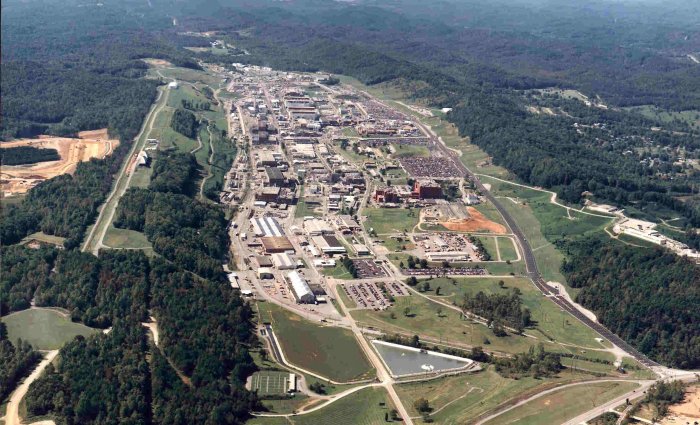Photo credit: US Department of Energy
Design and development of the 'Project Pegasus' enriched uranium facility at the Atomic Weapons Establishment (AWE) is proceeding hand-in-hand with work on a similar facility at a US nuclear weapons laboratory, according to documents released to Nuclear Information Service under the Freedom of Information Act (available to download at the bottom of this article).
Reports of exchange visits by AWE staff to the Y-12 National Security Complex at Oak Ridge, Tennessee, reveal that an extensive programme of co-operation has been established between the two labs to allow collaboration on process development, facility design, and strategic and safety issues such as fire protection, criticality safety, and security.
The Y-12 plant manufactures uranium sub-assembly components for US nuclear weapons and stores military stocks of highly enriched uranium. As part of a programme to modernise US nuclear weapons laboratories, a new Uranium Processing Facility is scheduled to be built at the site. The timetable for designing and building the facility coincides with the construction of Project Pegasus, a new enriched uranium facility at AWE Aldermaston. Project Pegasus will produce uranium components for UK nuclear weapons and highly enriched uranium fuel for nuclear submarine reactors, and will replace the ageing A45 facility at Aldermaston.
The exchange visit reports give an insight into the practicalities of co-operation on nuclear weapons between the USA and the UK and show the depth of joint working and collaboration. They relate to two visits made by AWE staff to Y-12 in July 2006 and October 2007, following agreement to establish a collaborative programme between the two labs in July 2005.
Joint work on criticality safety was used to inform design and safety case work on the AWE enriched uranium project, and information on the impact of fire protection standards on plant design and construction has also been shared. “Enhanced collaboration” arrangements were also agreed on manufacturing processes, including sharing of data and aligning of programmes on technology development and specification and procurement of a new machine tool.
The exchange reports shine a light on safety standards at Y-12, which came under considerable criticism from the AWE representatives. The British visitors describe the Y-12 facilities facilities as 'pre-Pochin', referring to a devastating report on radiological safety standards at AWE prepared in1978 by Sir Edward Pochin. Criticality safety was a particular issue, and the report of the July 2006 visit notes that “fissile material mass limits are significantly higher than those in AWE”. The report of the subsequent visit states that: “There was a very high tolerance of airborne and surface contamination that is not acceptable in the UK. There was no evidence of interstage checking from the radiological standpoint and no independent monitoring. There were also very high criticality safety limits, [redacted] much higher than those operated in AWE facilities”. As a result, AWE undertook to peer review and assist Y-12 with safety calculations in subsequent work.
The exchange visits took place under the terms of the US – UK Mutual Defense Agreement (MDA) of 1958, which authorises co-operation on nuclear weapons programmes between the two nations. Under the MDA around 40 Joint Working Groups (known as JoWoGs) have been established to allow collaboration on specific technical areas. The Y-12 – AWE exchange visits took place under the terms of JoWoG 39, which relates to manufacturing, and has the aim of “facilitating the exchange and peer review of information, as well as fostering collaborative programs, in all aspects of manufacturing between the United States through the Nuclear Weapons Complex and the United Kingdom through the Atomic Weapons Establishment (AWE)”. Although the reports relate to visits which took place several years ago, there is little doubt that co-operation on the UPF programme at Y-12 and AWE's Project Pegasus continues to the present day.
The two reports, marked as 'confidential', were released by the Ministry of Defence following a Freedom ofInformation Act request originally made in October 2008. Backed by the Information Commissioner, the Ministry of Defence initially refused to provide them on the grounds that US-UK relationships might be prejudiced, but backed down and released large parts of the documents in the face of an appeal to the Information Tribunal at the end of 2011.
Download the exchange visit reports here:
